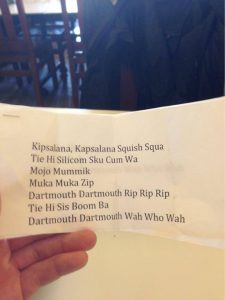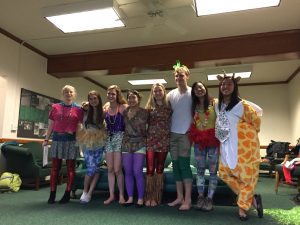Title: Post-practice chant
General Information about Item:
- Genre: Verbal and Customary Folklore
- Subgenre: chant
- Language: English
- Country of origin: USA
Informant Data: Will Kaufman ’20 is a 19-year-old male caucasian light-weight rower from Boulder, CO. He is the middle child between two sisters. He started rowing his freshman fall upon entering Dartmouth. As a walk-on rower, he came in knowing nothing about the sport.
Contextual Data:
Social Context: The chant occurs at the end of each practice. It involves a huddle, hands in toward the center, one person leading the chant, the whole team responding, throwing up the hands, and breaking from the circle. Afterwards, teammates go to dinner together, take showers, or split up. The coaches are not involved in the chant.
Cultural Context: In the athletic team culture, everything is about the group, not the individual. The rowers are a cohesive group that spend a significant amount of time together in the effort of creating strong bonds and success in competition. This chant helps bring everyone together at the end of practice to show that they are part of one team with the same goals. Their effort is beyond one practice or one individual.
Item: This chant occurs at the end of each practice. In a huddle the teammates put their hands in toward the center, recite the chant, throw up their hands, and break up.
Associated media:
https://www.youtube.com/watch?v=jaI34nMCWuc
Transcript of Associated File: “Let’s get a ‘Green’ on 3! 1, 2, 3 GREEN!”
Informant’s Comments: The informant emphasized the regularity and importance of this chant: “It feels weird if practice ends and everyone leaves” without doing the chant. That never happens.
Collector’s Comments:
- The chant is a formal indicator of the end of a routine time of bonding.
- The informant noted that when first learning this chant, the walk-on rowers are separated from the rest of the team, learn the chant, and are incorporated with the rest, where the entire team can perform the chant together. In this way, the events centered around the first chant resemble elements of a rite of passage.
Collector’s Name: Sam Gochman
Tags/Keywords: D150, Dartmouth Light-Weight Rowing, Chant, Customary, Verbal








